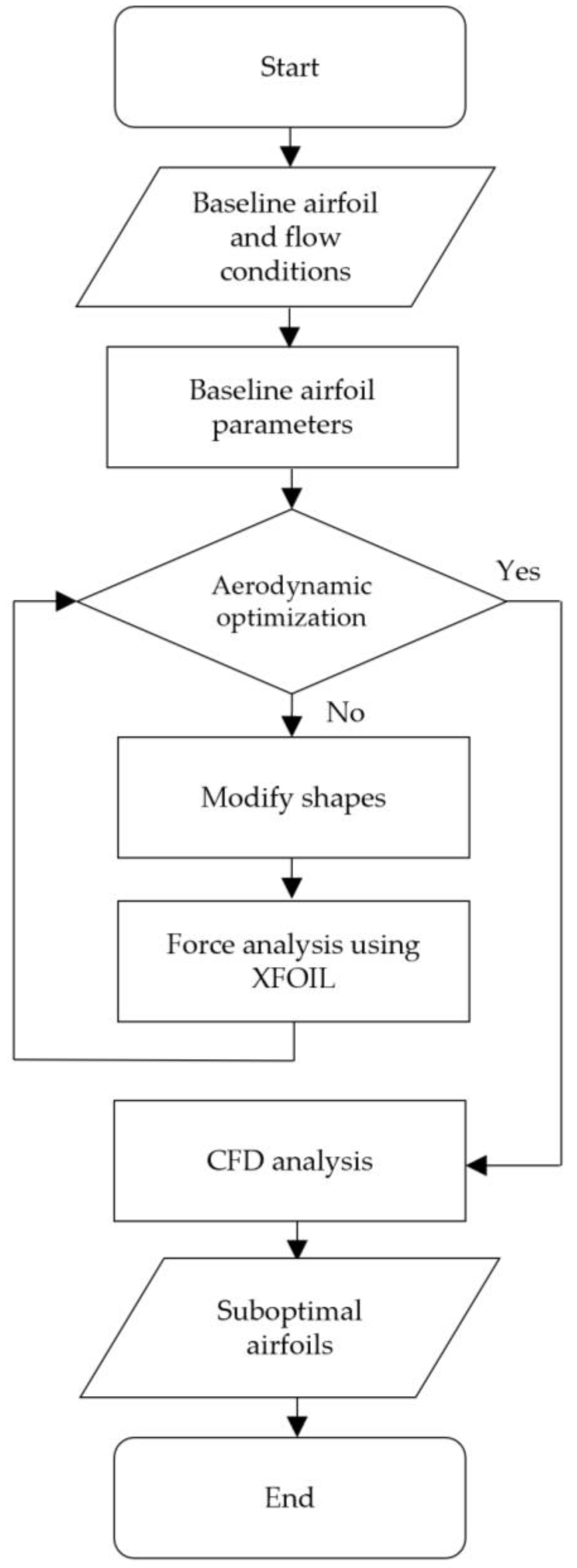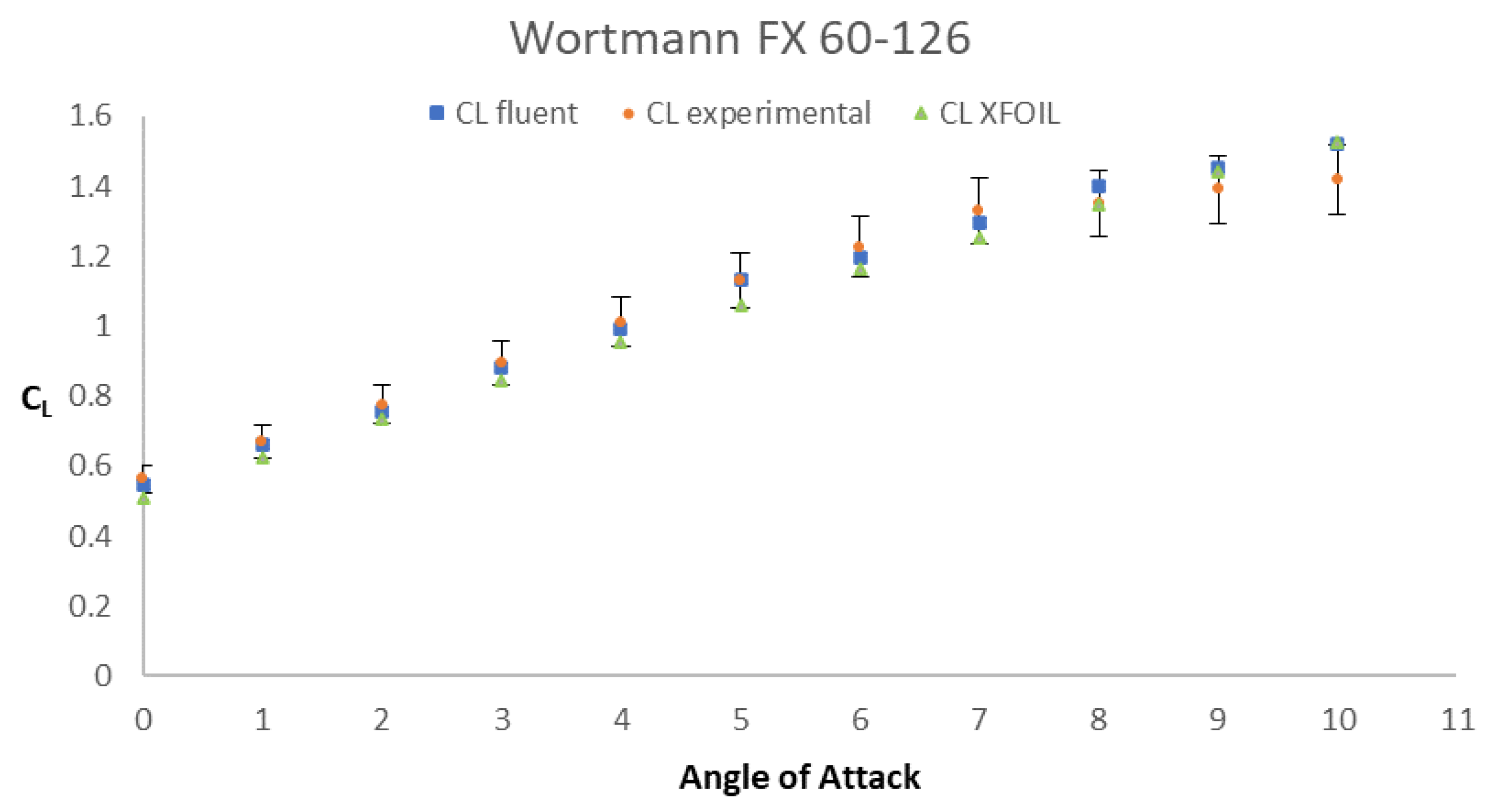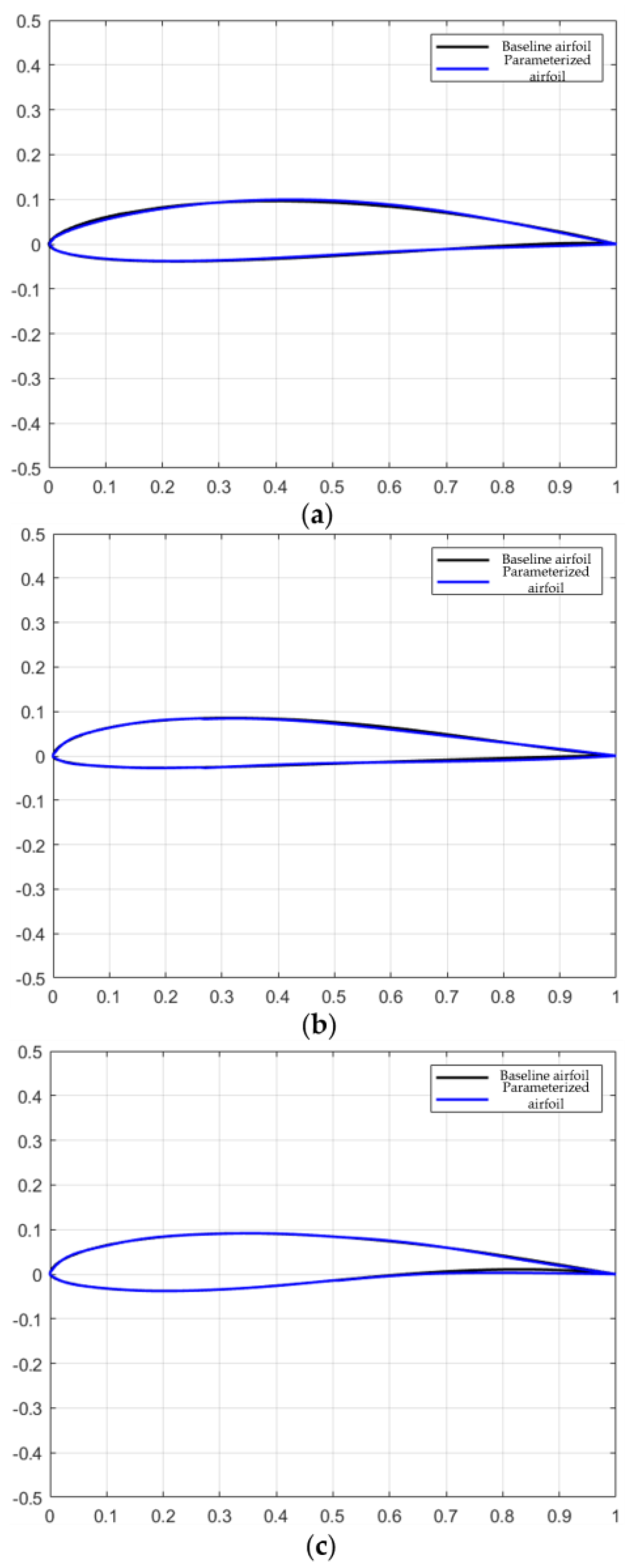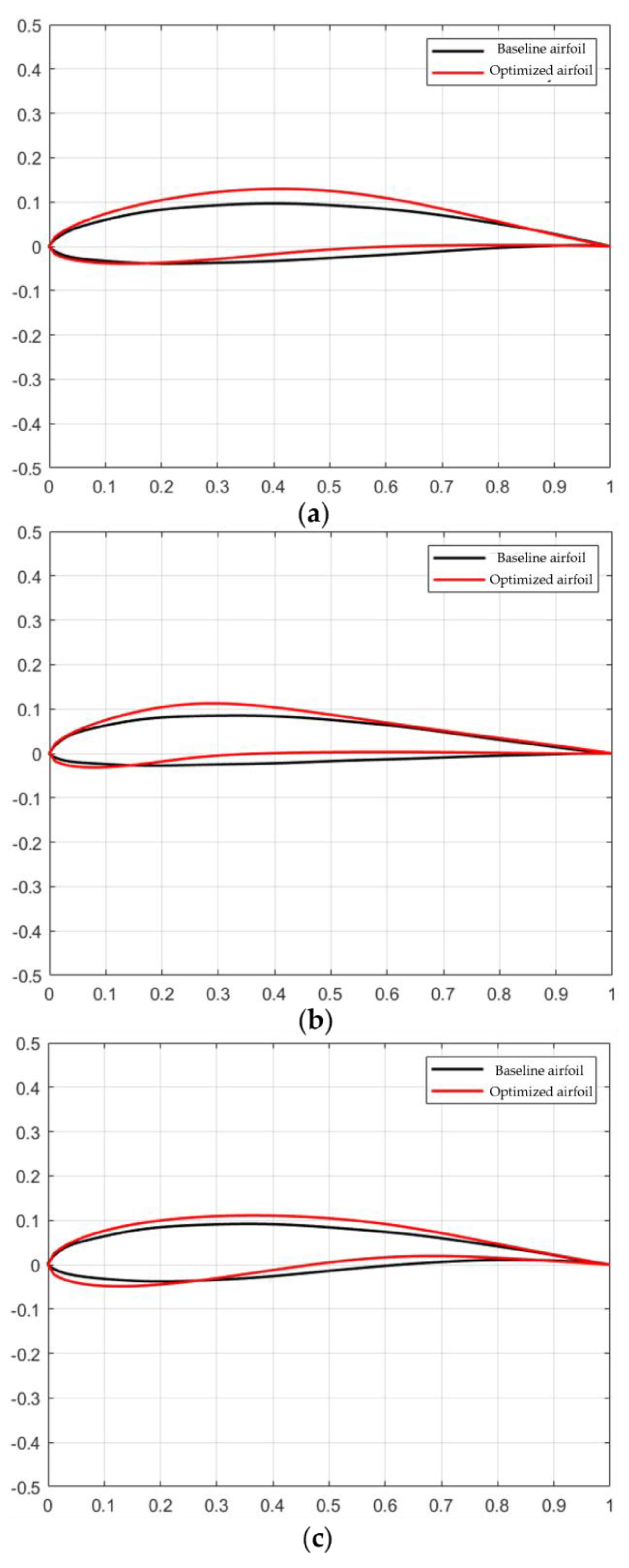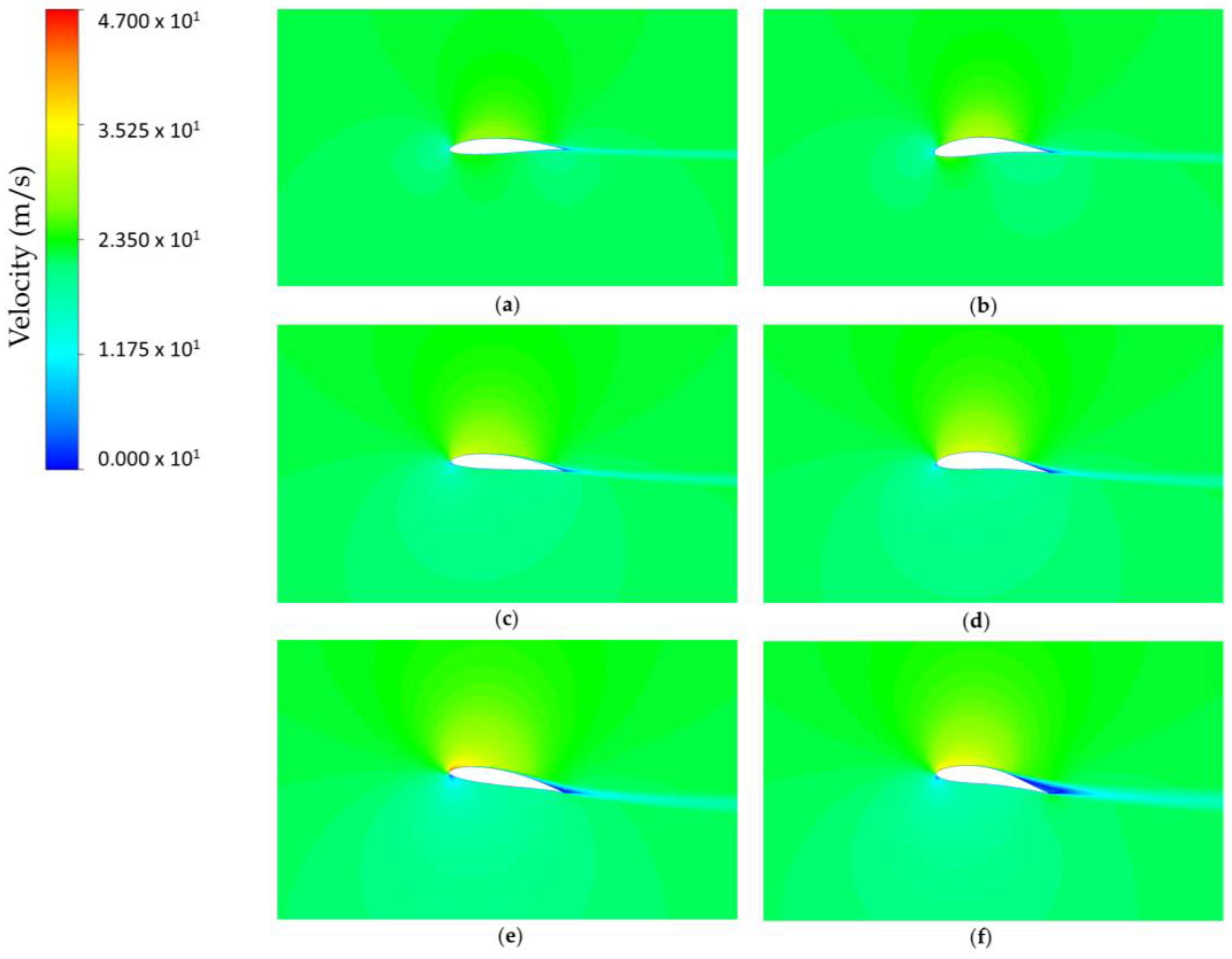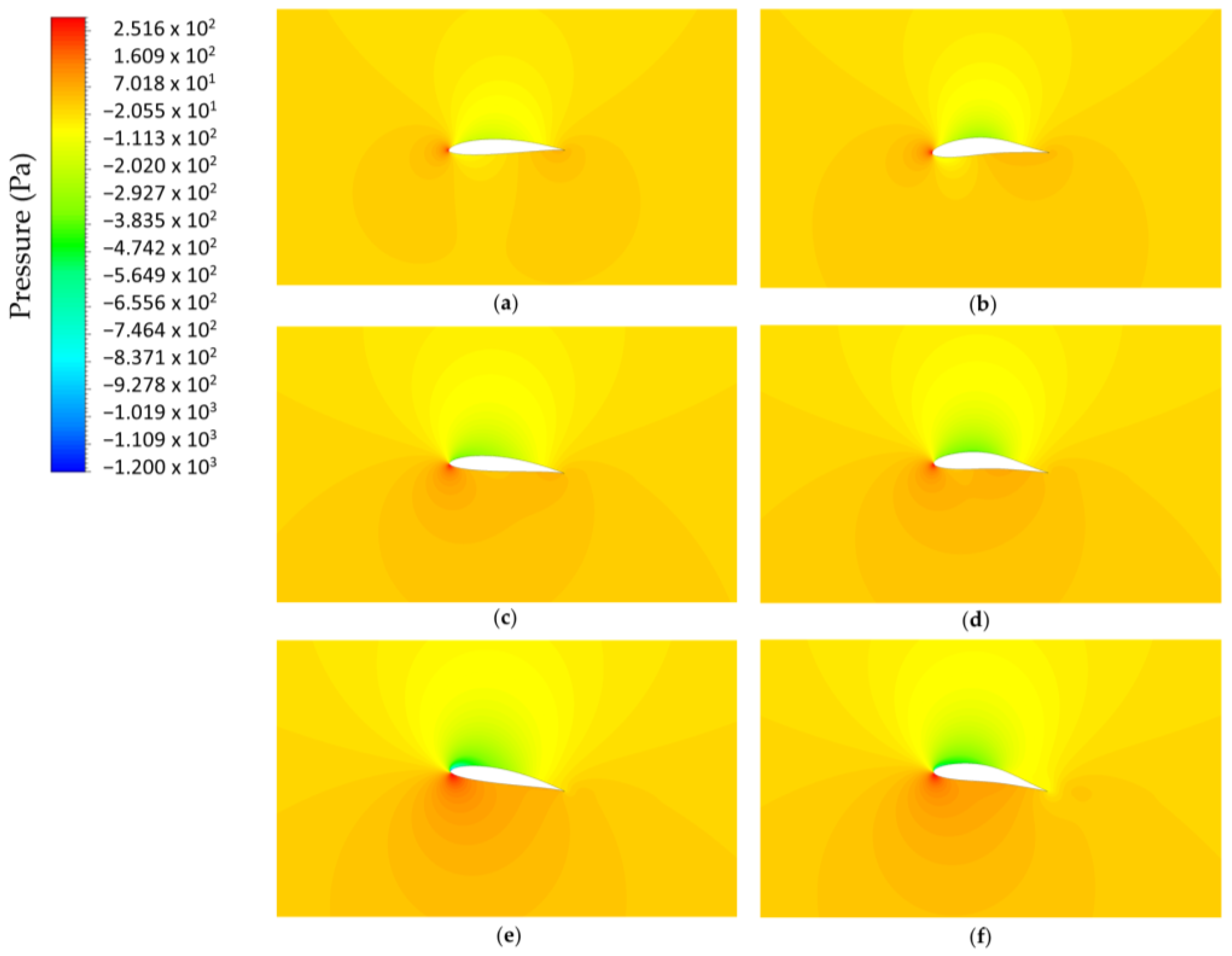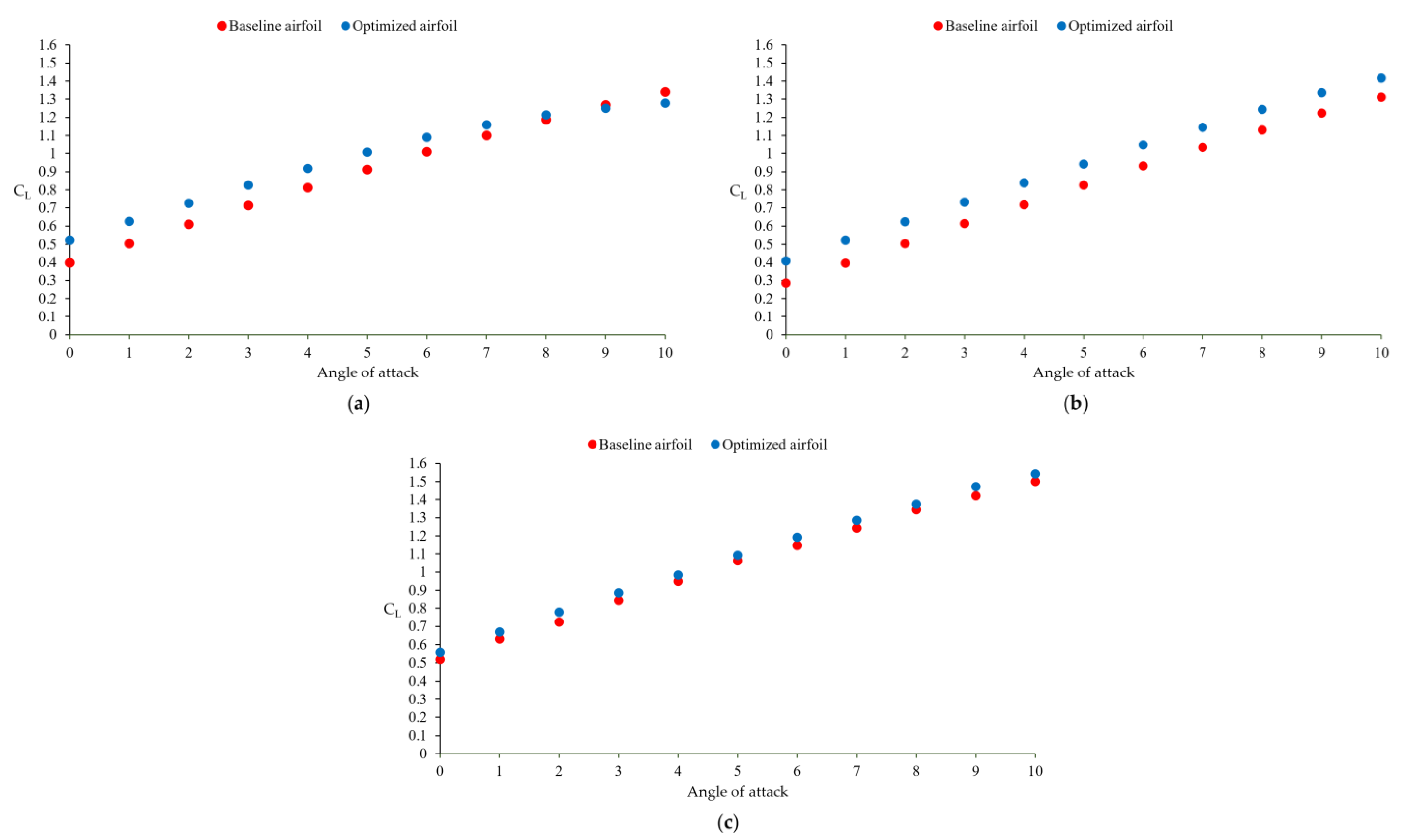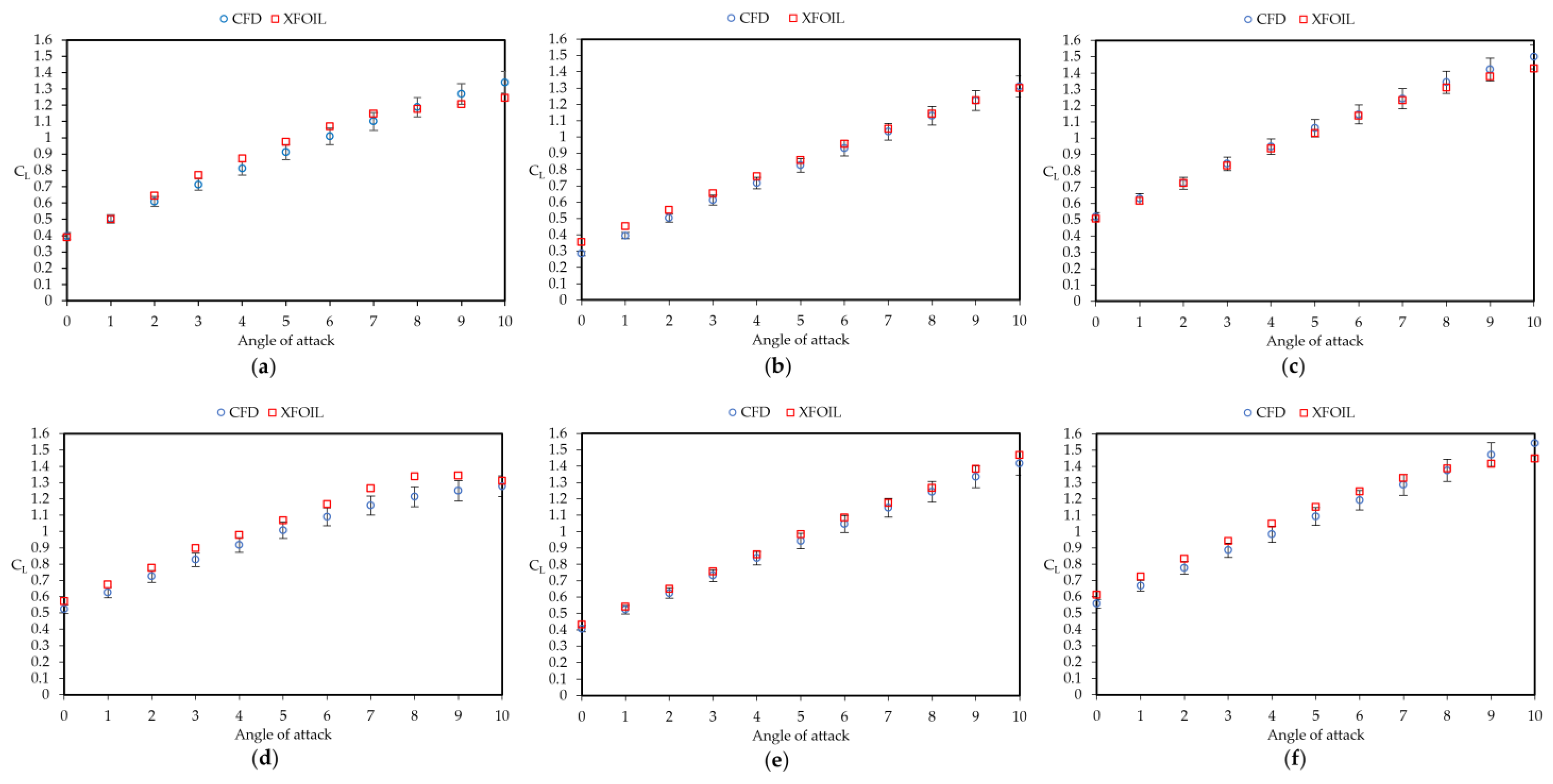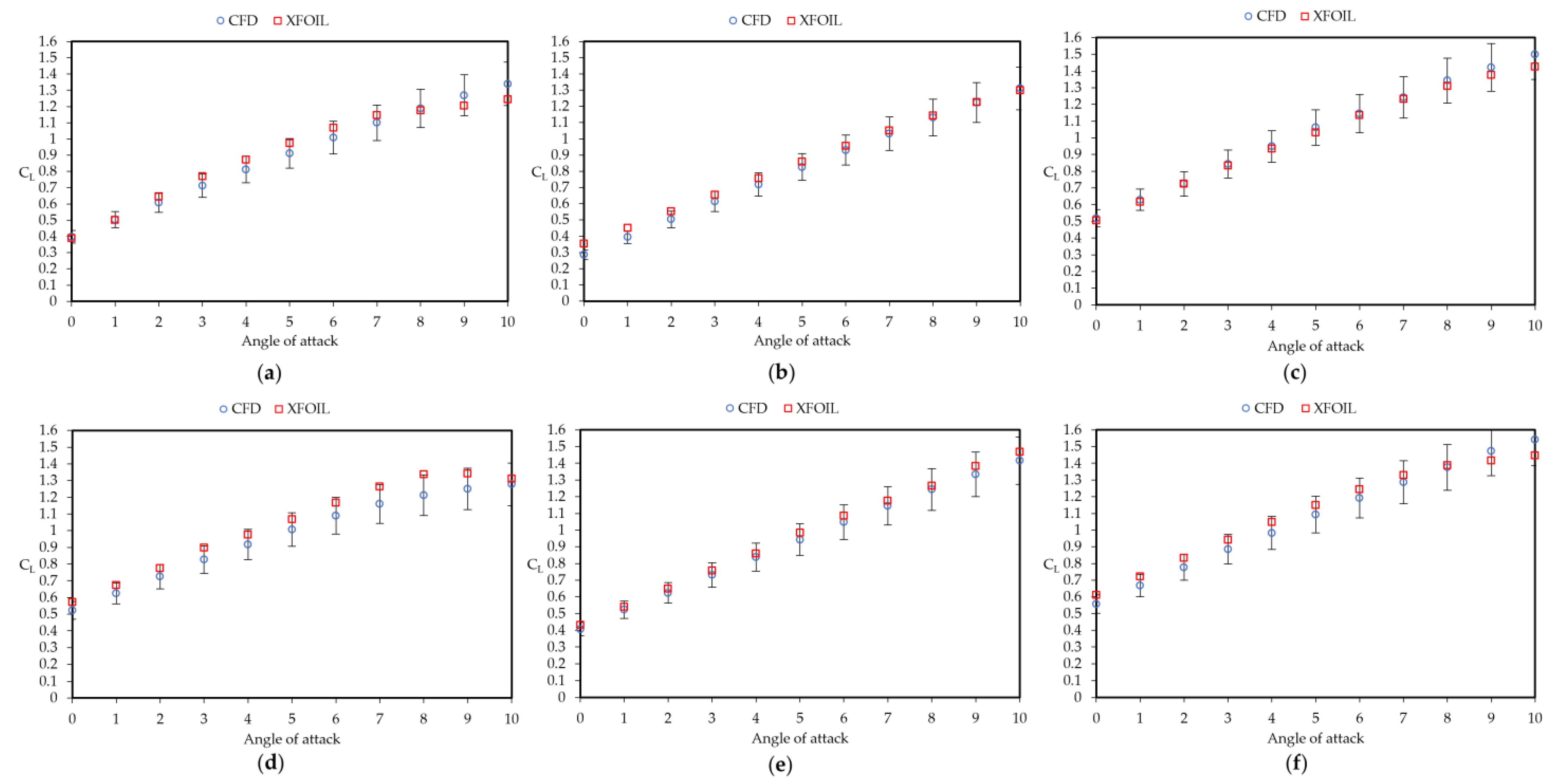Author Contributions
Conceptualization, M.E.T.-d.-C. and M.T.-V.; methodology, M.E.T.-d.-C., M.O.V.-Z. and M.T.-V.; software, M.E.T.-d.-C., M.A.F.-A. and M.T.-V.; validation, M.E.T.-d.-C., M.O.V.-Z., M.A.F.-A. and M.T.-V.; formal analysis, M.E.T.-d.-C., M.O.V.-Z. and M.T.-V.; investigation, M.E.T.-d.-C. and M.A.F.-A.; resources, M.O.V.-Z. and J.H.-H.; data curation, M.A.F.-A. and L.d.C.S.-C.; writing—original draft preparation, M.E.T.-d.-C. and M.A.F.-A.; writing—review and editing, M.O.V.-Z. and J.H.-H.; supervision, M.E.T.-d.-C. and M.O.V.-Z.; project administration, L.d.C.S.-C. All authors have read and agreed to the published version of the manuscript.
Figure 1.
Design process flowchart.
Figure 1.
Design process flowchart.
Figure 2.
IGP geometric parameters.
Figure 2.
IGP geometric parameters.
Figure 3.
Flowchart of the developed genetic algorithm.
Figure 3.
Flowchart of the developed genetic algorithm.
Figure 4.
(a) Entire mesh, (b) mesh around airfoil, and (c) mesh at the boundary layer.
Figure 4.
(a) Entire mesh, (b) mesh around airfoil, and (c) mesh at the boundary layer.
Figure 5.
Wortmann experimental data comparison at Re = 700,000.
Figure 5.
Wortmann experimental data comparison at Re = 700,000.
Figure 6.
Comparison of baseline airfoils drawn with x-y coordinates and parameterization: (a) Eppler 68, (b) MH 70, and (c) Wortmann FX 60-126.
Figure 6.
Comparison of baseline airfoils drawn with x-y coordinates and parameterization: (a) Eppler 68, (b) MH 70, and (c) Wortmann FX 60-126.
Figure 7.
Comparison of parameterized baseline and optimized airfoils: (a) Eppler 68, (b) MH 70, and (c) Wortmann FX 60-126.
Figure 7.
Comparison of parameterized baseline and optimized airfoils: (a) Eppler 68, (b) MH 70, and (c) Wortmann FX 60-126.
Figure 8.
Comparison of velocity profiles for baseline Eppler 68 at angles, (a) 0°, (c) 5°, and (e) 10°, with respect to optimized Eppler 68 at angles, (b) 0°, (d) 5°, and (f) 10°.
Figure 8.
Comparison of velocity profiles for baseline Eppler 68 at angles, (a) 0°, (c) 5°, and (e) 10°, with respect to optimized Eppler 68 at angles, (b) 0°, (d) 5°, and (f) 10°.
Figure 9.
Comparison of pressure contours for baseline Eppler 68 at angles, (a) 0°, (c) 5°, and (e) 10°, with respect to optimized Eppler 68 at angles, (b) 0°, (d) 5°, and (f) 10°.
Figure 9.
Comparison of pressure contours for baseline Eppler 68 at angles, (a) 0°, (c) 5°, and (e) 10°, with respect to optimized Eppler 68 at angles, (b) 0°, (d) 5°, and (f) 10°.
Figure 10.
Comparison of CL vs. angle of attack for baseline and optimized airfoils: (a) Eppler 68, (b) MH 70, and (c) Wortmann FX 60-126, with data obtained from XFOIL.
Figure 10.
Comparison of CL vs. angle of attack for baseline and optimized airfoils: (a) Eppler 68, (b) MH 70, and (c) Wortmann FX 60-126, with data obtained from XFOIL.
Figure 11.
Comparison of CL vs. angle of attack for baseline and optimized airfoils: (a) Eppler 68, (b) MH 70, and (c) Wortmann FX 60-126, with data obtained from CFD.
Figure 11.
Comparison of CL vs. angle of attack for baseline and optimized airfoils: (a) Eppler 68, (b) MH 70, and (c) Wortmann FX 60-126, with data obtained from CFD.
Figure 12.
5% uncertainty plot between data from CFD and XFOIL for baseline airfoils, (a) Eppler 68, (b) MH 70, and (c) Wortmann FX 60-126, and optimized airfoils, (d) Eppler 68, (e) MH 70, and (f) Wortmann FX 60-126.
Figure 12.
5% uncertainty plot between data from CFD and XFOIL for baseline airfoils, (a) Eppler 68, (b) MH 70, and (c) Wortmann FX 60-126, and optimized airfoils, (d) Eppler 68, (e) MH 70, and (f) Wortmann FX 60-126.
Figure 13.
10% uncertainty plot between data from CFD and XFOIL for baseline airfoils, (a) Eppler 68, (b) MH 70, and (c) Wortmann FX 60-126, and optimized airfoils, (d) Eppler 68, (e) MH 70, and (f) Wortmann FX 60-126.
Figure 13.
10% uncertainty plot between data from CFD and XFOIL for baseline airfoils, (a) Eppler 68, (b) MH 70, and (c) Wortmann FX 60-126, and optimized airfoils, (d) Eppler 68, (e) MH 70, and (f) Wortmann FX 60-126.
Table 1.
Reynolds and Mach numbers for selected UAVs.
Table 1.
Reynolds and Mach numbers for selected UAVs.
| Parameter | Reynolds Number | Mach Number |
|---|
| UAV 1 | 101,520 | 0.0275 |
| UAV 2 | 276,822 | 0.0868 |
| UAV 3 | 271,663 | 0.0686 |
| UAV 4 | 356,449 | 0.0878 |
| UAV 5 | 363,219 | 0.0607 |
| UAV 6 | 323,012 | 0.0894 |
| UAV 7 | 574,351 | 0.0805 |
| UAV 8 | 642,989 | 0.1133 |
Table 2.
Features of three meshes for mesh sensitivity analysis.
Table 2.
Features of three meshes for mesh sensitivity analysis.
| Parameter | Mesh 1 | Mesh 2 | Mesh 3 |
|---|
| Number of elements | 200,900 | 128,720 | 72,540 |
| Number of nodes | 200,000 | 128,000 | 72,000 |
| Face size | 6 | 6 | 6 |
| Edge sizing number | 18 | 18 | 18 |
| Maximum ortho skew | 0.485 | 0.487 | 0.491 |
| Minimum orthogonal quality | 0.514 | 0.512 | 0.508 |
Table 3.
Boundary conditions.
Table 3.
Boundary conditions.
| Property | Value |
|---|
| Velocity | 22 m/s |
| Viscosity | 1.789 × 10−5 kg/ms |
| Density | 1.225 kg/m3 |
| Temperature | 288.15 k |
| Molecular weight | 28.97 mol |
| Specific heat | 1.007 KJ/kg K |
| Thermal conductivity | 0.0253 W/m K |
Table 4.
Parameterization of the baseline airfoils.
Table 4.
Parameterization of the baseline airfoils.
| Airfoil | | | | | | | | |
|---|
| Eppler 68 | 0.0333421 | 0.5183947 | 0.1310699 | 0.3545151 | 0.2183493 | 0.2430516 | 0.1041607 | 1.4664183 |
| MH 70 | 0.0308708 | 0.3812709 | 0.1099443 | 0.2642141 | 0.2574286 | 0.2383815 | 0.0411869 | 1.6385809 |
| Wortmann FX 60-126 | 0.0355857 | 0.5752508 | 0.1253141 | 0.2675585 | 0.2672425 | 0.2648604 | 0.1009438 | 0.8993897 |
Table 5.
Winning average CL for airfoils Eppler 68, MH 70, and Wortmann FX 60-126 by generation.
Table 5.
Winning average CL for airfoils Eppler 68, MH 70, and Wortmann FX 60-126 by generation.
| Eppler 68 | MH 70 | Wortmann FX 60-126 |
|---|
| Number of Generations | Winning Average CL | Number of Generations | Winning Average CL | Number of Generations | Winning Average CL | Number of Generations | Winning Average CL |
|---|
| 1 | 0.84867273 | 14 | 1.01404545 | 1 | 0.86660909 | 1 | 1.03812727 |
| 2 | 0.87700909 | 15 | 1.01404545 | 2 | 0.86660909 | 2 | 1.03812727 |
| 3 | 0.87700909 | 16 | 1.03525455 | 3 | 0.86660909 | 3 | 1.03812727 |
| 4 | 0.87700909 | 17 | 1.03525455 | 4 | 0.86665455 | 4 | 1.03866364 |
| 5 | 0.96570909 | 18 | 1.03525455 | 5 | 0.86665455 | 5 | 1.03866364 |
| 6 | 0.96570909 | 19 | 1.03525455 | 6 | 0.86665455 | 6 | 1.07715455 |
| 7 | 0.97150909 | 20 | 1.03525455 | 7 | 0.86665455 | 7 | 1.09464545 |
| 8 | 1.01368182 | 21 | 1.03525455 | 8 | 0.91632727 | 8 | 1.09464545 |
| 9 | 1.01368182 | 22 | 1.03525455 | 9 | 0.91632727 | 9 | 1.09464545 |
| 10 | 1.01368182 | 23 | 1.03525455 | 10 | 0.91632727 | 10 | 1.09464545 |
| 11 | 1.01368182 | 24 | 1.03525455 | 11 | 0.96380909 | 11 | 1.09464545 |
| 12 | 1.01368182 | 25 | 1.03525455 | | | 12 | 1.09464545 |
| 13 | 1.01368182 | 26 | 1.03527273 | | | 13 | 1.10314545 |
Table 6.
Parameterization of the optimized airfoils.
Table 6.
Parameterization of the optimized airfoils.
| Airfoil | | | | | | | | |
|---|
| Eppler 68 | 0.03745613 | 0.47035912 | 0.15131985 | 0.3156055 | 0.23365106 | 0.32906381 | 0.14806868 | 0.93750603 |
| MH 70 | 0.0350260 | 0.33361382 | 0.12258109 | 0.21663074 | 0.34868941 | 0.25570580 | 0.09749409 | 1.30056557 |
| Wortmann FX 60-126 | 0.03522693 | 0.52329478 | 0.14475579 | 0.22277039 | 0.42739378 | 0.26984099 | 0.15241569 | 0.73403739 |
Table 7.
Statistics of improvements of optimized and baseline airfoils from XFOIL.
Table 7.
Statistics of improvements of optimized and baseline airfoils from XFOIL.
| Airfoil | Average Percentage Increase in CL | Minimum CL Increase | Maximum CL Increase |
|---|
| Eppler 68 | 17.243 | 0.0682 | 0.1814 |
| MH 70 | 14.967 | 0.077 | 0.1689 |
| Wortmann FX 60-126 | 10.708 | 0.0215 | 0.1188 |
Table 8.
Statistics of improvements of optimized and baseline airfoils from CFD.
Table 8.
Statistics of improvements of optimized and baseline airfoils from CFD.
| Airfoil | Average Percentage Increase in CL | Minimum CL Increase | Maximum CL Increase |
|---|
| Eppler 68 | 12.328 | 0.0615 | 0.1252 |
| MH 70 | 18.171 | 0.1065 | 0.1284 |
| Wortmann FX 60-126 | 4.444 | 0.0311 | 0.0532 |
